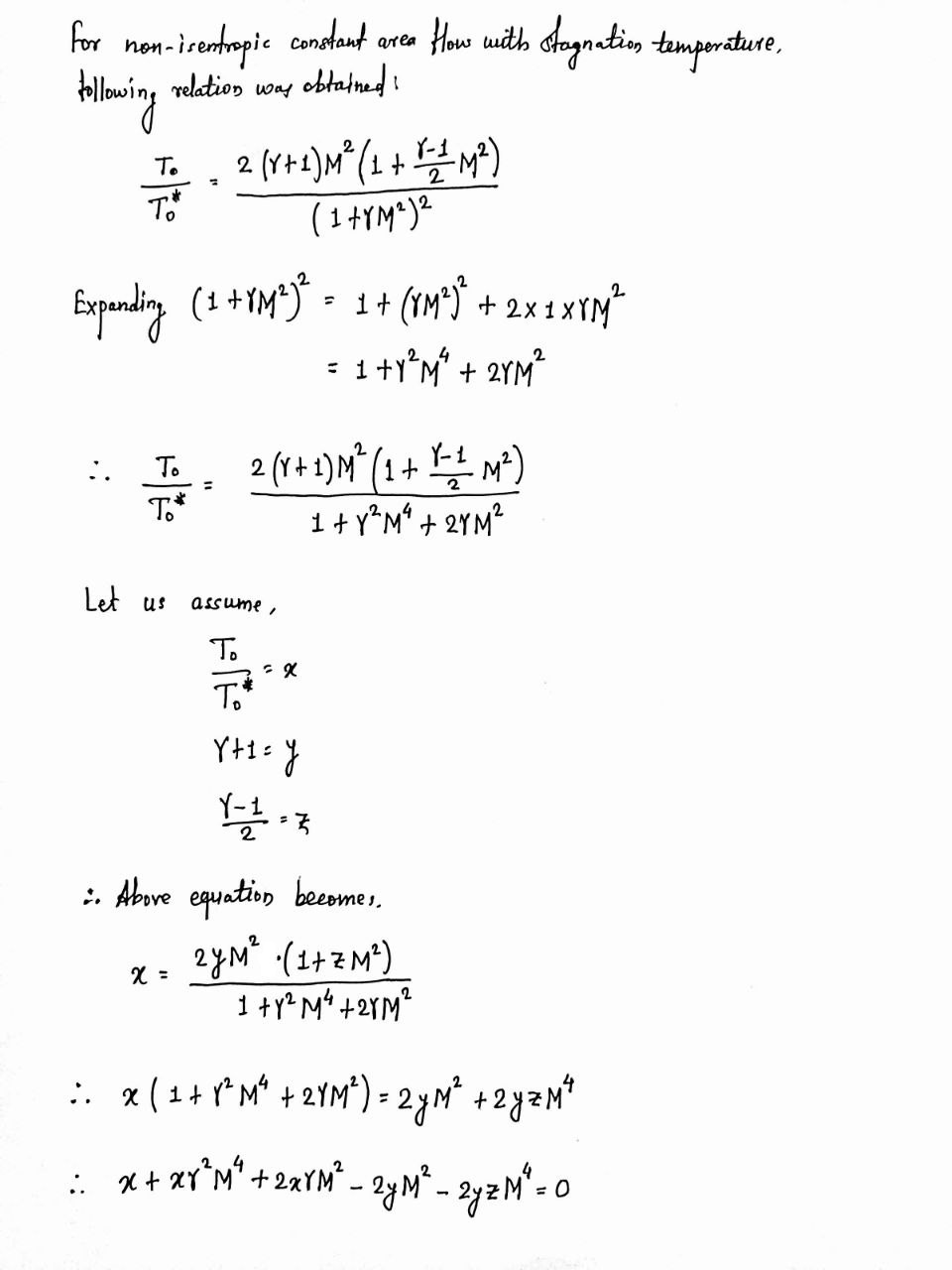For non-isentropic constant-area flow with stagnation temperature change the following relation was determined: To_2(y + 1)M² (1 + ² = ¹ M²) - 2 = (1+yM²)² To It is possible to use the above equation and calculate the downstream Mach number without resorting to iteration for a flow where the upstream Mach number, as well as the upstream and downstream stagnation temperatures, are known. This is a common calculation for flows through engine combustors. Presuming the left side is a known quantity, show that the above equation can be directly solved as a quadratic in M² and which roots correspond to the subsonic/supersonic solution. Rewrite the equation as: aMª + bM² + c = 0, and then M² = (−b ± √b² − 4ac)/2a. Determine the appropriate expressions for a, b, and c.
For non-isentropic constant-area flow with stagnation temperature change the following relation was determined: To_2(y + 1)M² (1 + ² = ¹ M²) - 2 = (1+yM²)² To It is possible to use the above equation and calculate the downstream Mach number without resorting to iteration for a flow where the upstream Mach number, as well as the upstream and downstream stagnation temperatures, are known. This is a common calculation for flows through engine combustors. Presuming the left side is a known quantity, show that the above equation can be directly solved as a quadratic in M² and which roots correspond to the subsonic/supersonic solution. Rewrite the equation as: aMª + bM² + c = 0, and then M² = (−b ± √b² − 4ac)/2a. Determine the appropriate expressions for a, b, and c.
Elements Of Electromagnetics
7th Edition
ISBN:9780190698614
Author:Sadiku, Matthew N. O.
Publisher:Sadiku, Matthew N. O.
ChapterMA: Math Assessment
Section: Chapter Questions
Problem 1.1MA
Related questions
Question

Transcribed Image Text:For non-isentropic constant-area flow with stagnation temperature change the following
relation was determined:
Y
1
To _ ²(y + 1)M² (1 + ¹ Z ¹ M²)
2
TO
(1+yM²)²
It is possible to use the above equation and calculate the downstream Mach number without
resorting to iteration for a flow where the upstream Mach number, as well as the upstream
and downstream stagnation temperatures, are known. This is a common calculation for flows
through engine combustors.
Presuming the left side is a known quantity, show that the above equation can be directly
solved as a quadratic in M² and which roots correspond to the subsonic/supersonic solution.
Rewrite the equation as: aM4 + bM² + c = 0, and then M² = (−b ± √b² - 4ac)/2a.
Determine the appropriate expressions for a, b, and c.
Expert Solution
Step 1

Trending now
This is a popular solution!
Step by step
Solved in 2 steps with 2 images

Knowledge Booster
Learn more about
Need a deep-dive on the concept behind this application? Look no further. Learn more about this topic, mechanical-engineering and related others by exploring similar questions and additional content below.Recommended textbooks for you

Elements Of Electromagnetics
Mechanical Engineering
ISBN:
9780190698614
Author:
Sadiku, Matthew N. O.
Publisher:
Oxford University Press

Mechanics of Materials (10th Edition)
Mechanical Engineering
ISBN:
9780134319650
Author:
Russell C. Hibbeler
Publisher:
PEARSON

Thermodynamics: An Engineering Approach
Mechanical Engineering
ISBN:
9781259822674
Author:
Yunus A. Cengel Dr., Michael A. Boles
Publisher:
McGraw-Hill Education

Elements Of Electromagnetics
Mechanical Engineering
ISBN:
9780190698614
Author:
Sadiku, Matthew N. O.
Publisher:
Oxford University Press

Mechanics of Materials (10th Edition)
Mechanical Engineering
ISBN:
9780134319650
Author:
Russell C. Hibbeler
Publisher:
PEARSON

Thermodynamics: An Engineering Approach
Mechanical Engineering
ISBN:
9781259822674
Author:
Yunus A. Cengel Dr., Michael A. Boles
Publisher:
McGraw-Hill Education

Control Systems Engineering
Mechanical Engineering
ISBN:
9781118170519
Author:
Norman S. Nise
Publisher:
WILEY

Mechanics of Materials (MindTap Course List)
Mechanical Engineering
ISBN:
9781337093347
Author:
Barry J. Goodno, James M. Gere
Publisher:
Cengage Learning

Engineering Mechanics: Statics
Mechanical Engineering
ISBN:
9781118807330
Author:
James L. Meriam, L. G. Kraige, J. N. Bolton
Publisher:
WILEY